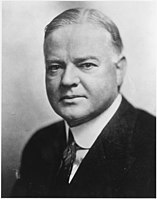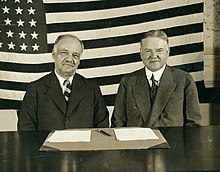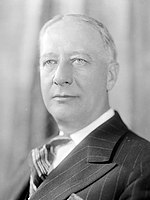
A | B | C | D | E | F | G | H | CH | I | J | K | L | M | N | O | P | Q | R | S | T | U | V | W | X | Y | Z | 0 | 1 | 2 | 3 | 4 | 5 | 6 | 7 | 8 | 9
| |||||||||||||||||||||||||||||
531 members of the Electoral College 266 electoral votes needed to win | |||||||||||||||||||||||||||||
|---|---|---|---|---|---|---|---|---|---|---|---|---|---|---|---|---|---|---|---|---|---|---|---|---|---|---|---|---|---|
| Turnout | 56.9%[1] | ||||||||||||||||||||||||||||
| |||||||||||||||||||||||||||||
 Presidential election results map. Red denotes states won by Hoover/Curtis, blue denotes those won by Smith/Robinson. Numbers indicate the number of electoral votes allotted to each state. | |||||||||||||||||||||||||||||
| |||||||||||||||||||||||||||||
The 1928 United States presidential election was the 36th quadrennial presidential election, held on Tuesday, November 6, 1928. Republican former Secretary of Commerce Herbert Hoover defeated the Democratic nominee, Governor Al Smith of New York. After President Calvin Coolidge declined to seek reelection, Hoover emerged as his party's frontrunner. As Hoover's party opponents failed to unite around a candidate, Hoover received a large majority of the vote at the 1928 Republican National Convention. The strong state of the economy discouraged some Democrats from running, and Smith was nominated on the first ballot of the 1928 Democratic National Convention. Hoover and Smith had been widely known as potential presidential candidates long before the 1928 campaign, and both were generally regarded as outstanding leaders. Both were newcomers to the presidential race and presented in their person and record an appeal of unknown potency to the electorate. Both faced serious discontent within their respective parties' membership, and both lacked the wholehearted support of their parties' organization.[2]

In the end, the Republicans were identified with the booming economy of the 1920s, and Smith, a Roman Catholic, suffered politically from anti-Catholic prejudice, his opposition to Prohibition, and his association with the legacy of corruption by Tammany Hall. Hoover won a third straight Republican landslide and made substantial inroads in the traditionally-Democratic Solid South by winning several states that had not voted for a Republican since the end of Reconstruction. Hoover's victory made him the first president born west of the Mississippi River, and he is the most recent former member of the Cabinet to win a presidential election. Charles Curtis was elected vice president, becoming the first Native American and the first person with acknowledged non-European ancestry to reach that office, a feat that was not repeated until 2021, when Kamala Harris became vice president under President Joe Biden. Hoover would be the last Republican to win a presidential election until 1952.
Nominations
Republican Party nomination
 | |||||||||||||||||||||||||||||
| Herbert Hoover | Charles Curtis | ||||||||||||||||||||||||||||
|---|---|---|---|---|---|---|---|---|---|---|---|---|---|---|---|---|---|---|---|---|---|---|---|---|---|---|---|---|---|
| for President | for Vice President | ||||||||||||||||||||||||||||
 |
 | ||||||||||||||||||||||||||||
| U.S. Secretary of Commerce (1921–1928) |
U.S. Senator from Kansas (1907–1913 & 1915–1929) | ||||||||||||||||||||||||||||
| ID: 208 votes[3] HCV: 837 votes 2,045,928 votes | |||||||||||||||||||||||||||||
Other Candidates
| Candidates in this section are sorted by their highest vote count on the nominating ballot | ||||||
| Frank Orren Lowden | Charles Curtis | James Eli Watson | George W. Norris | Guy D. Goff | Calvin Coolidge | Frank B. Willis |
|---|---|---|---|---|---|---|
 |
 |
 |
 |
 |
 |
 |
| Governor of Illinois (1917–1921) |
U.S. Senator from Kansas (1924–1929) |
U.S. Senator from Indiana (1916–1933) |
U.S. Senator from Nebraska (1913–1943) |
U.S. Senator from West Virginia (1925–1931) |
U.S. President from Massachusetts (1923–1929) |
U.S. Senator from Ohio (1921–1928) |
| ID: 111 votes[3] W: Before 1st Ballot HCV: 74 votes 1,317,799 votes |
ID: 23 votes[3] HCV: 64 votes 0 votes |
ID: 33 votes[3] HCV: 45 votes 228,795 votes |
ID: 27 votes[3] HCV: 24 votes 259,548 votes |
ID: 0 votes[3] HCV: 18 votes 128,429 votes |
DTR ID: 10 votes[3] HCV: 17 votes 12,985 votes |
Died: March 30 84,461 votes |

With President Calvin Coolidge choosing not to seek re-election, the race for the nomination was wide open. The leading candidates were Secretary of Commerce Herbert Hoover, former Illinois Governor Frank Orren Lowden and Senate Majority Leader Charles Curtis. A movement to draft Coolidge failed to gain traction with party insiders or even persuade Coolidge himself.[4][5]
In the few primaries that mattered, Hoover did not perform as well as expected, leaving him with fewer than half the number of pledged delegates that he needed to win the nomination. Lowden in turn only had half the number of delegates that Hoover did, leaving it looking unlikely that the first rounds of voting would produce a majority for any candidate. Attempts were made to sound out Coolidge and Vice President Charles G. Dawes as to whether they would be willing to enter the race and break a potential deadlock between Hoover and Lowden, but both Coolidge and Dawes remained aloof. The matter was unexpectedly resolved when the convention voted to adopt a platform that repudiated the McNary–Haugen Farm Relief Bill, in turn causing Lowden to withdraw his candidacy in protest, and leaving no obvious challenger to Hoover. The only real competition that remained came from Senator Curtis, whose campaign was left with far too little time to win over the Lowden supporters.[6]
The Republican Convention was held in Kansas City, Missouri from June 12 to 15 and nominated Hoover on the first ballot. With Hoover disinclined to interfere in the selection of his running mate, the party leaders were at first partial to giving Dawes a shot at a second term, but when that information leaked, Coolidge sent an angry telegram that said that he would consider a second nomination for Dawes, whom he hated, a "personal affront."[7] To attract votes from farmers who were concerned about Hoover's pro-business orientation, the nomination was instead offered to Curtis. He accepted and was nominated overwhelmingly on the first ballot.[8] Curtis was the first candidate of Native American ancestry nominated by a major party for national office.
In his acceptance speech eight weeks after the convention ended, Hoover said: "We in America today are nearer to the final triumph over poverty than ever before in the history of this land... We shall soon with the help of God be in sight of the day when poverty will be banished from this land."[9] That sentence would haunt Hoover during the Great Depression.
| Presidential Ballot | Vice Presidential Ballot | ||
|---|---|---|---|
| Herbert Hoover | 837 | Charles Curtis | 1,052 |
| Frank Orren Lowden | 74 | Herman Ekern | 19 |
| Charles Curtis | 64 | Charles G. Dawes | 13 |
| James Eli Watson | 45 | Hanford MacNider | 2 |
| George W. Norris | 24 | ||
| Guy D. Goff | 18 | ||
| Calvin Coolidge | 17 | ||
| Charles G. Dawes | 4 | ||
| Charles Evans Hughes | 1 |


